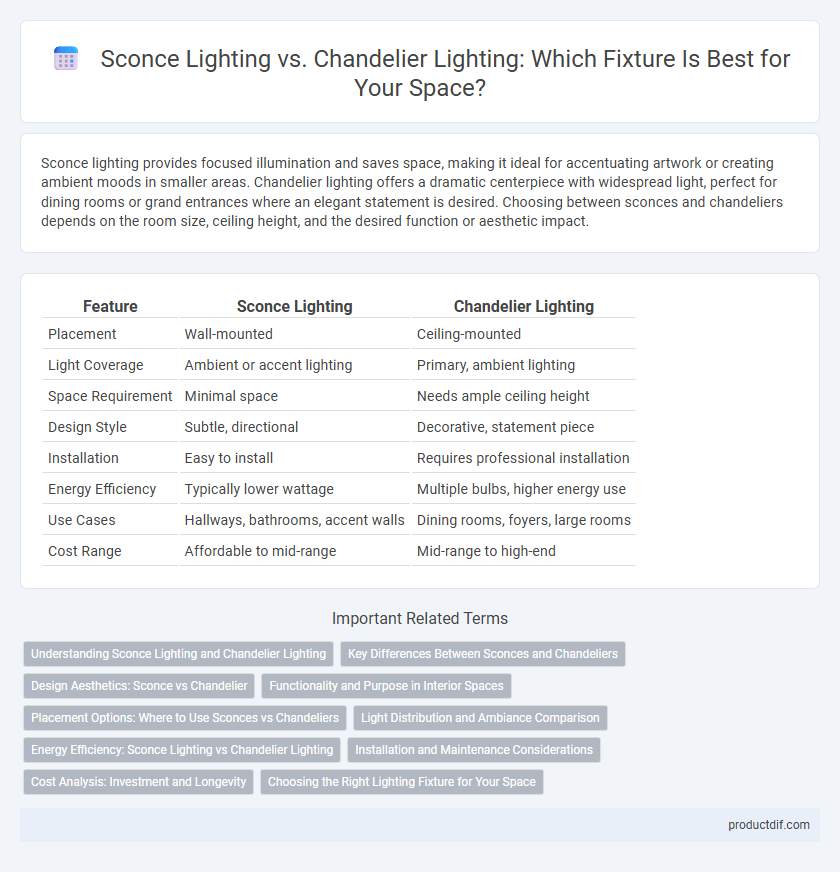Sconce lighting provides focused illumination and saves space, making it ideal for accentuating artwork or creating ambient moods in smaller areas. Chandelier lighting offers a dramatic centerpiece with widespread light, perfect for dining rooms or grand entrances where an elegant statement is desired. Choosing between sconces and chandeliers depends on the room size, ceiling height, and the desired function or aesthetic impact.
Table of Comparison
| Feature | Sconce Lighting | Chandelier Lighting |
|---|---|---|
| Placement | Wall-mounted | Ceiling-mounted |
| Light Coverage | Ambient or accent lighting | Primary, ambient lighting |
| Space Requirement | Minimal space | Needs ample ceiling height |
| Design Style | Subtle, directional | Decorative, statement piece |
| Installation | Easy to install | Requires professional installation |
| Energy Efficiency | Typically lower wattage | Multiple bulbs, higher energy use |
| Use Cases | Hallways, bathrooms, accent walls | Dining rooms, foyers, large rooms |
| Cost Range | Affordable to mid-range | Mid-range to high-end |
Understanding Sconce Lighting and Chandelier Lighting
Sconce lighting provides focused illumination by mounting directly on walls, offering ambient or accent lighting ideal for hallways and small spaces. Chandelier lighting serves as a central ceiling fixture, delivering broad, decorative illumination suited for dining rooms or entryways. Both lighting types enhance interior design, with sconces emphasizing subtlety and chandeliers highlighting grandeur.
Key Differences Between Sconces and Chandeliers
Sconce lighting offers wall-mounted illumination typically designed for accent or task lighting, creating subtle ambiance with limited spatial impact, making it ideal for narrow or smaller spaces. Chandeliers provide ceiling-mounted, central lighting fixtures with multiple bulbs or light sources, delivering a dramatic visual focal point and enhanced brightness suitable for larger rooms or formal settings. The key differences lie in their installation location, light dispersion, scale, and functional purpose within interior design.
Design Aesthetics: Sconce vs Chandelier
Sconce lighting offers a minimalist and space-saving design that enhances wall architecture with soft, ambient illumination, creating an intimate atmosphere suited for modern and transitional interiors. Chandelier lighting serves as a bold centerpiece, providing dramatic visual impact and opulent elegance through intricate designs and multiple light sources, ideal for grand spaces and traditional decor. Both fixtures complement interior styles differently, with sconces emphasizing subtle sophistication and chandeliers showcasing ornamental luxury.
Functionality and Purpose in Interior Spaces
Sconce lighting provides targeted illumination ideal for accentuating artwork or creating ambient lighting in hallways and smaller spaces, enhancing wall features without overwhelming the room. Chandelier lighting serves as a central focal point, offering broad, diffused light that fills larger areas such as dining rooms or entryways, contributing to both illumination and decorative appeal. Choosing between sconces and chandeliers depends on the desired light distribution and the spatial function, balancing form and functionality in interior design.
Placement Options: Where to Use Sconces vs Chandeliers
Sconce lighting works best in narrow hallways, beside mirrors, or flanking doorways where wall space is available, providing focused and ambient illumination without occupying ceiling height. Chandeliers suit larger rooms such as dining areas, foyers, or living rooms with high ceilings, serving as a central decorative element and offering widespread lighting coverage. Choosing between sconces and chandeliers depends on spatial dimensions, ceiling height, and desired light distribution in the room.
Light Distribution and Ambiance Comparison
Sconce lighting provides focused, ambient illumination by casting light upward or downward, creating subtle shadows that enhance wall textures and add cozy warmth to smaller spaces. Chandelier lighting offers a more centralized and diffused light distribution, often serving as a focal point that amplifies elegance and sets a dramatic ambiance in larger rooms. While sconces contribute to layered lighting schemes with softer, mood-enhancing effects, chandeliers deliver brighter, more uniform illumination suited for grand, open areas.
Energy Efficiency: Sconce Lighting vs Chandelier Lighting
Sconce lighting typically uses lower wattage bulbs and directs light more efficiently onto specific areas, resulting in reduced energy consumption compared to chandelier lighting, which often requires multiple high-wattage bulbs to illuminate large spaces. LED sconce fixtures further enhance energy efficiency by minimizing power usage without sacrificing brightness. Choosing sconce lighting over chandeliers can lead to significant energy savings, especially in residential and small commercial environments.
Installation and Maintenance Considerations
Sconce lighting offers easier installation due to its wall-mounted design, requiring fewer electrical connections and less structural support compared to chandeliers, which often need ceiling reinforcement and professional wiring expertise. Maintenance of sconces is simpler, involving straightforward bulb replacement and light fixture cleaning without specialized equipment. Chandeliers demand more intensive upkeep, including careful dusting of multiple components and potential chandelier height adjustments, often necessitating ladders or scaffolding.
Cost Analysis: Investment and Longevity
Sconce lighting typically offers a lower upfront investment compared to chandelier lighting, making it a cost-effective option for enhancing ambiance with localized illumination. Chandeliers, while often pricier due to intricate design and higher material costs, provide extended longevity and can increase property value through their statement aesthetic and durable construction. Evaluating long-term energy efficiency and maintenance expenses reveals sconces may incur lower costs, but chandeliers deliver a better return on investment in upscale settings.
Choosing the Right Lighting Fixture for Your Space
Sconce lighting offers targeted illumination and saves floor space, making it ideal for narrow hallways and accent lighting, while chandelier lighting provides a bold focal point with widespread ambient light suited for dining rooms and entryways. Consider ceiling height, room size, and style when selecting between sconces and chandeliers to ensure balanced brightness and aesthetic harmony. Prioritize energy-efficient LED options and fixtures that complement the room's architectural features for optimal functional and decorative impact.
Sconce lighting vs Chandelier lighting Infographic

 productdif.com
productdif.com